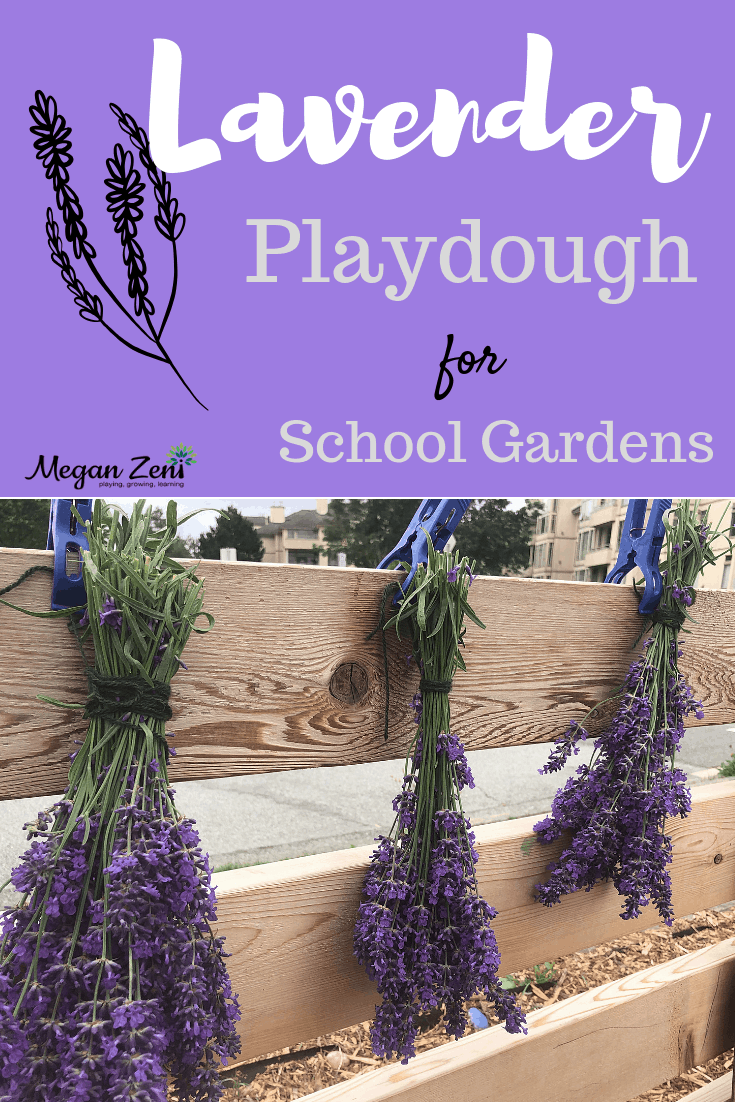- filed under: Loose Parts, Nature Inspired Arts & Crafts
Easy Lavender Playdough
Playdough is surprisingly entertaining for kids of all ages. Adding lavender playdough as a sensorial play opportunity in the school garden becomes a delightful way to integrate student learning and core competency skill development with the natural world. This simple play staple engages children in imaginative play while increasing communication, cooperation, fine motor skills, and creative thinking.
Easy Lavender Playdough
Lavender is in full bloom in our June garden so we decided that it would be fun for the kids to fold and squish some into the playdough for a sensorial experience. Before making the playdough we harvested just enough lavender for the project, which worked out to be about one handful for 5 students. We then we chopped up the lavender into tiny pieces. Originally we left the lavender chunky and also picked some mint leaves, but we soon found the students preferred (and found it easier) to incorporate smaller chunks of lavender into the playdough.
How To Make Playdough
To make the playdough we used a basic recipe. Since we did this lesson with multiple classes, we had to make a lot of playdough, so we kept it simple:
10tbsp vegetable oil
1 Cup Boiling Water
Once all ingredients were combined, we wrapped up the playdough in cling wrap, then sealed it in a plastic bag and into an airtight container to keep the playdough from drying out between classes.
Playful Learning With Playdough
As the students were playing with the playdough we could observe the many benefits that playdough has to offer. While using the playdough, the children’s learning was supported in many different areas:
- The students were able to explore their ideas and try different approaches to building and incorporating the lavender.
- Students used many different techniques such as smashing, flattening, pounding, and rolling the dough out.
- Some students pretended to make food, which is similar play to the kind of play that occurs in the mud kitchen.
- Students were pretending to be chefs and bakers and started to produce lavender doughnuts, pizza, cookies, and spaghetti.
- Other students made a guessing game. They would make something out of their playdough and their classmates would then guess what their creation was.
- Some students also connected their playdough to the garden and decided to make worms, snakes, caterpillars and other creatures that live in the garden.
- In experimenting with the playdough, the children were able to engage in creative and imaginative play across curricular areas.
Lavender Maintenance
If you have lavender growing in your school garden be sure to care for it with some yearly maintenance to ensure beautiful blooms year after year. In our garden, we harvest all the blooms down to the green shrubby growth each June. The bundles of lavender can be hung to dry and will retain their colour and scent for the coming school year’s crafts and projects. If you leave the blooms on the shrub, they’ll be grey and dull by fall and your plant will become “leggy”, which means it will lose that nice mounded shape. We do another hard pruning during the late winter months to discourage the plant from forming the woody stems that give the plant that undesirable leggy look that mature lavender shrubs can grow.
The above post was co-created by student teachers from the University Of British Columbia completing their community field experience in the outdoor classroom & school garden. Thank you to Simryn Mann, Sarah Reid, and Amy Baatz for their outstanding contributions to student learning, and for sharing this prepared sensorial play experience in the school garden.



